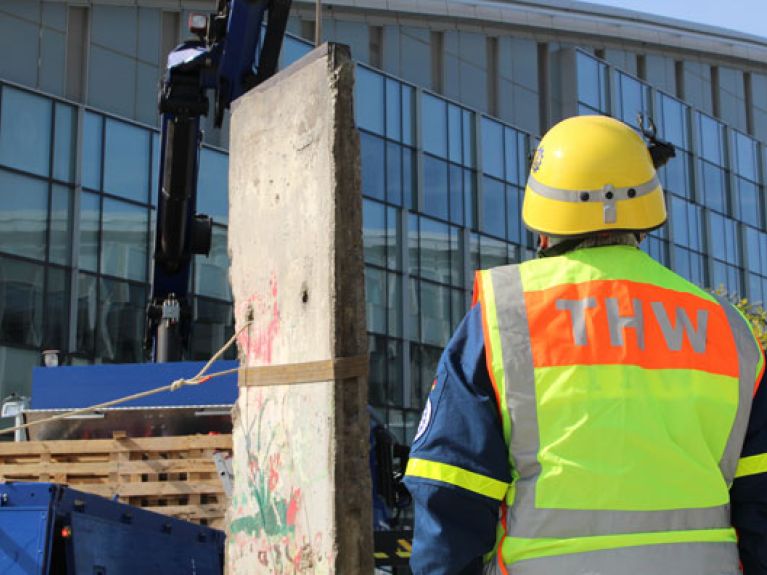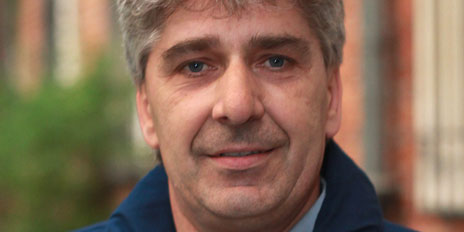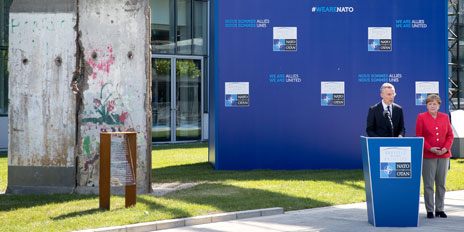“Brimming with history”
Frank Kukuk from the federal agency THW helped dismantle the Berlin Wall in the early 1990s. Now he has re-erected two pieces of the Wall in Brussels, in front of the new NATO headquarters.

In April 2017, Franz Kukuk, a volunteer at the Technisches Hilfswerk (German Federal Agency for Technical Relief, THW) in the Berlin Charlottenburg-Wilmersdorf branch office, installed two segments of the Berlin Wall in front of the new NATO headquarters in Brussels together with four colleagues. The monument was unveiled on 25 May 2017 by Federal Chancellor Angela Merkel in the presence of NATO Secretary General Jens Stoltenberg and numerous heads of state and government of the NATO countries. Franz Kukuk, born in 1958, talks about his exciting job of installing the monument – and why he already transported sections of the Wall in the early 1990s.

“I was three years old when the Wall was built. I grew up in West Berlin, in the Charlottenburg district. We saw the Wall as restrictive, of course, but somehow it was also normal; that was simply our world. It was different for the older generation; they had had the freedom to travel and had known an undivided city.
“Quite a monster”
I wouldn’t have thought that almost 30 years after the Wall came down I would come into contact with it once again, through the THW. But in mid-March 2017 we got a request from the Federal Foreign Office to transport two sections of the Wall from Berlin to Brussels and to install them in front of the new NATO headquarters. Our branch office didn’t have a crane to lift the heavy blocks, so we had to borrow one from the Berlin Reinickendorf branch. We collected the sections from a concrete company that had bought lots of pieces of the Wall cheaply after it had been dismantled to mark the boundary of its premises. First they were preserved and then we loaded them very carefully, protecting them with anti-slip mats and straps. After all, each section weighs 2.7 tonnes – and is brimming with history. My colleague had inspected the site in front of the new NATO headquarters in advance and packed four brooms just in case. And indeed, the path to the grassy area was pretty overgrown; lots of trees with lots of thick branches. Our lorry is almost four metres high and 2.50 m wide; quite a monster. We used the brooms to press the branches to the sides so that nothing got broken – I think that left a lasting impression at NATO.

I joined the THW in 1981, out of curiosity. My two brothers were involved and I asked them: What do you do there? They said: Why don’t you come and see? That’s how I joined; 36 years ago on 19 May 2017. There were far fewer operations back then; we were still in the middle of the Cold War and everything was oriented purely on civil protection and not on cooperation with the emergency response authorities. I joined the rescue group as a driver.
In the early 1990s, after the Wall came down, the THW was requested to help the East German border troops dismantle the border fortifications. I worked with five or six others on dismantling the Wall in Berlin’s Wannsee district. I can’t say whether or not we were happy to be talking to the border troops; we didn’t know one another – they were complete strangers to us. But I was very proud to be there as the Wall was taken away. We drove there with our dump trucks, they loaded the pieces of the Wall onto them and then they came to Michendorf with us, south of Potsdam. The region was totally foreign to us; we hadn’t been allowed to go there for decades.
“Operations abroad are something special”
The sections of the Wall looked perfectly normal, grey and made of very hard reinforced concrete, but weren’t painted as nicely as other segments. On the western side of the Wall some properties had been built directly onto it – the owners had used it as a rear wall for their garages; after all, you have to use every square metre of space. But our task was to get rid of it all. When the Wall was demolished, some pieces had garden hoses and other things still hanging from them and we were able to look directly into the open garages. The owners of the houses were no doubt less amused.
I’ve been abroad with the THW eleven or twelve times – operations abroad are always something special. The first was in Ethiopia in 1985, two stretches of four weeks at the time of the great drought and famine. Ethiopia didn’t have enough working lorries to transport the many tonnes of food donations from all over the world throughout the country. So we flew down there, repaired lorries and trained locals. You need to not only want to help, but also be able to help, be flexible and versatile. Later I took part in operations in Azerbaijan, Rwanda, Sierra Leone and Liberia. There is so much I could tell!
The sections of the Berlin Wall we have now installed are impressive. One bears the letters “Gorb” – I think it once stood close to the Brandenburg Gate. I never go to look at the remains of the Wall in Berlin; you just don’t do that if you are from Berlin yourself. I’ve been to the Eiffel Tower in Paris, had my picture taken – but the Parisians don’t do that either. It is simply different if you are a tourist or if you live in the city. It is far better living here without the Wall. But now we seem to be coming full circle.”
The German Federal Agency for Technical Relief, the Technisches Hilfswerk (THW), is the Federation’s voluntary civil protection organization. The THW is an agency in the department of the Federal Ministry of the Interior. It has some 1,200 full-time staff and more than 80,000 volunteers, roughly half of whom are fully-qualified members of the task force. The THW and NATO are closely linked via civil-military cooperation in the area of humanitarian aid. For this reason, the THW was asked to install two sections of the Berlin Wall in front of the new NATO headquarters in Brussels in the context of the mutual assistance programme.
Minutes: Sarah Kanning
Dossier: 25 years of German unity
© www.deutschland.de

